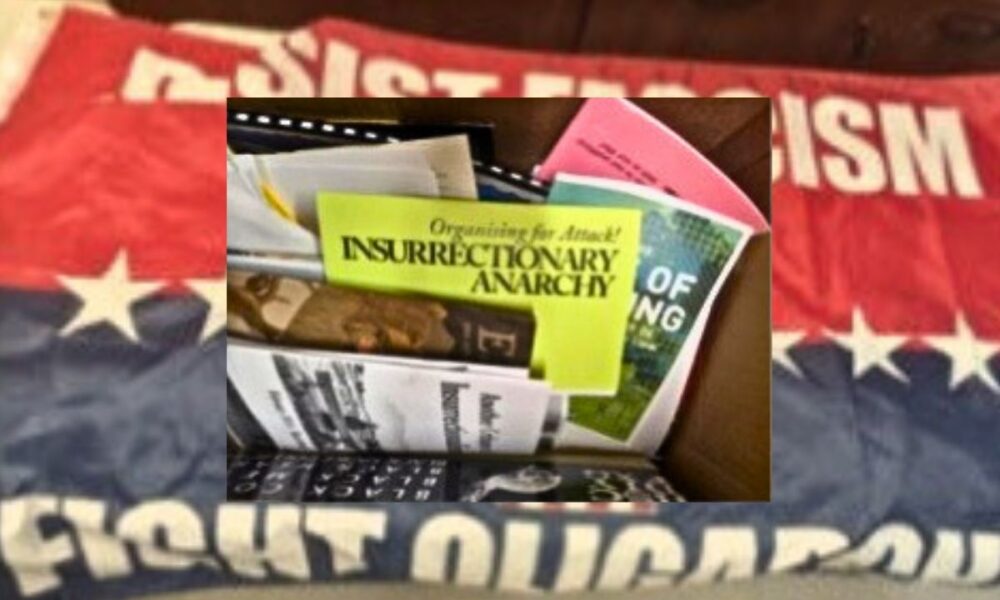After a group of militants ambushed an ICE facility near Fort Worth, officials seized anarchist propaganda that could help shed light on their motives.
Assailants in black body armor reportedly surrounded the ICE Prairieland Detention Facility in Alvarado, south of Fort Worth, late on July 4, as The Dallas Express reported. They ambushed law enforcement, shooting an Alvarado police officer in the neck and firing dozens of rounds at ICE corrections officers.
As The Dallas Express reported, Acting U.S. Attorney Nancy Larson called it “a planned ambush with the intent to kill ICE corrections officers.”
Officials charged 10 suspects, each with three counts for attempted murder of federal officers and firing a gun in a violent crime. An eleventh suspect was charged with obstruction of justice and conspiracy for allegedly attempting to destroy evidence.
During the investigation, officials found numerous guns and suits of body armor. They also found anarchist propaganda – including a flag that read “resist fascism, fight oligarchy” and flyers that said “fight ICE terror with class war” and “free all political prisoners.”
After searching a Denton apartment connected to one of the suspects, the FBI found literature titled Organizing for Attack! Insurrectionary Anarchy.
The anti-ICE assailants vandalized cars, had anarchist propaganda, and black body armor. pic.twitter.com/YyIVnr3SZV
— Logan Washburn (@loganwashburn76) July 8, 2025
The Dallas Express reviewed this manifesto, published in 2003, and found that it calls for acts of violence against the government.
“The state has to be knocked out of existence by the exploited and excluded, thus anarchists must attack: waiting for the state to disappear is defeat,” it reads. “It is through acting and learning to act, not propaganda, that we will open the path to insurrection.”
Kyle Shideler, director of homeland security and counterterrorism at the Center for Security Policy, told The Dallas Express that the attack apparently aligns with the manifesto’s belief system.
“For insurrectionary anarchists, police in particular are a highly desirable target,” Shideler said.
He cited “Armed Joy,” a 1977 work by Alfredo M. Bonanno, which issued a call to action with the following command: “Hurry comrade, shoot the policeman, the judge, the boss. Now, before a new police prevent you.”
Anarchists have been frustrated with the failure of “widespread protests” for years, according to Shideler. He said tension has been growing between anarchists and Marxist-Leninists, like the Party for Socialism and Liberation.
“While we can’t know for certain what the alleged attackers took from the pamphlet unless we learn more,” he said, “their actions are aligned with the beliefs of insurrectionary anarchists, who emphasize provocative and often violent direct action attacks over protests, organizing, or other forms of politics.”
The Manifesto
Organizing for Attack! Insurrectionary Anarchy says adherents must take actions that become “mass insurrections – that is to say actual revolutions.” They aim to “destroy the capitalist order of the world.”
“The state will not wither away, as it seems many anarchists have come to believe,” it reads. “Waiting only teaches waiting; in acting one learns to act.”
The document cited the uprisings in Paris in May 1968, the armed insurrections in Italy in the 1970s, and the unrest in Albania in the late 1990s. It stated that attacks cannot remain isolated and must spread.
“Small actions – which require unsophisticated means that are available to all and thus are easily reproducible – are by their very simplicity and spontaneity uncontrollable,” it reads. “They make a mockery of even the most advanced technological developments in counter-insurgency.”
Action must remain independent to keep anarchist activity true to its principles, according to the manifesto, which called for “no compromise” in the goal of destroying authority.
“Revolutionary solidarity is always an active attack; it always involves the recovery of our own active powers that multiply in combination – in solidarity – with the active powers of others,” the document reads.
It encourages anarchists to store up anger when they witness perceived injustice, so they can turn it into violence later.
“I again open up this special compartment and put the anger of some new atrocity in it, all in anticipation of the day when I shall need this anger to bring the Empire down.”
“I perceive my anger calling me from inside this compartment, I hear the door unlatching from inside, and this new terrible question approaches me: How shall I know when it’s time for insurrection?”


